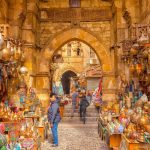Facts About Karnak Temple
We will know everything about the fact of Karnak Temple in detail through this blog post from FTS blog.
Luxor is one of Egypt’s most valuable inheritances when it comes to ancient Egyptian civilization.
The Karnak Temple is one of Luxor’s beautiful temples, among many impressive ancient monuments.
The Heritage of Karnak Temple
The Karnak Temple was constructed in devotion to the god Amun and enlarged by a sequence of pharaohs, from the Middle Kingdom (1965-1920 BC) to the Ptolemaic dynasty (305 BC to 30 BC). The outcome is a fantastic maze of temples, shrines, sphinxes, columns, and pylons, among many other ancient structures, and its name is ‘fortified village’ in Arabic.
The Temple of Amun-Ra, with its globe Great Hypostyle Hall, is among the most important and remarkable sites at the Karnak Temple complex. The discussion over whether this looming framework with its 69-foot columns was built by Amenhotep III or Seti I continues, even though Seti I finished it.
the Karnak Temple Now
Karnak Temple, which is massive and full of fascinating sites, is Egypt’s second-most popular website (after the Giza pyramids) now and serves as the Karnak Open Air Museum. Most visitors spend a couple of hours at Karnak Temple, but this is only a tiny portion of this ancient complex, only the Precinct of Amun-Re.
The Precincts of Mut and Montu, as well as the intentionally dismantled Temple of Amenhotep IV, are all closed to traffic and are in various stages of reconstruction after being used to construct other structures. Nonetheless, this must-see ancient treasure is an overpowering antiquity treasure, with its pillars significantly lit up by afternoon sunlight.
The Wadjet Hall
Thutmose I constructed Wadjet Hall close to the main sanctuary, between the fourth and fifth pylons. The hall attempts to measure about 246 feet by 46 feet; it was utilized for the king’s coronation and heb-sed festival.
The heb-sed festival was usually held 30 years after a king took the throne and every three years after that.
Pylons of Karnak
Beginning in the New Empire and persisting for centuries, Egyptian rulers progressively built a series of ten pylons at Karnak. These towers will indeed serve as gateways and were linked together by a network of walls.
The Pylons have frequently adorned with various scenes of the ruler who commissioned their construction.
The pylons at Karnak begin close to the main sanctuary and extend in 2 ways. The first six pylons face west, towards the Nile River, and finish in an entry lined with an avenue of tiny sphinxes, while the second four pylons face south, across a waterfront promenade in use for celebrations.
How to Get to Karnak Temple
The Karnak Temple, located on the outskirts of Luxor along the Nile River, is quickly accessible by foot or public transportation – the temple is only a 40-minute walk from the railway station with connections to Cairo or Aswan. Luxor is located just off the 75 highway and is a 15-minute drive from Luxor Airport Terminal.
Why is the Karnak Temple so well-known?
The Temple of Karnak was thought to be the site of the beginning of time. They also thought it was a point of contact between the god Amun-Ra and the Egyptians. It is significant in Egypt’s social heritage as it was a worship site and contains information about ancient Egyptian religion.
What was the purpose of Karnak?
Karnak is believed to have been an ancient observation deck in addition to a site of worship where the god Amun would communicate directly with the earth’s inhabitants.
Karnak has a high sensory capacity, nearly like being and augmented by mental discipline, to interpret tensile stress, rupture planes, or weak points in artifacts, people, or even communities.
How did the Karnak Temple come to be destroyed?
The World Heritage Sites of Amun, Luxor, and Karnak survived 4,000 years of desert heat but are currently being destroyed by rising groundwater.
Who was the founder of the Karnak Temple?
Both temples were constructed during the rule of Amenhotep III (1390-53), whose architect is remembered in the Temple of Mut by statues. The impressive metropolitan temple of the state god, Amon-Re, stood between such two precincts. It was Egypt’s largest temple complex and one of the biggest in the world.
Who was revered at Karnak?
Karnak was a size relative in Upper Egypt devoted solely to the local god Amun a thousand years after the Great Pyramids were constructed. Nevertheless, the Eighteenth Dynasty rose to power.
Which king finished the Karnak Temple?
The end of Nectanebo I
Nectanebo I, the 30th and ultimate dynasty of ancient Egypt oversaw the last major building program at Karnak. He ruled from 380 to 362 B.C. Egypt would’ve been controlled by people direct descendants from Persia, Greece, or Rome after his dynasty concluded.
What became of Karnak?
Karnak used his skills to verify his passage, and then he cleared the rubble. He was then decided to join by Black Bolt, who notified him of Gorgon’s death before the two conducted him outside. They, after which arranged him down, as well as the remainder of the family, wept for him.
Was there a roof on Karnak Temple?
The term hypostyle refers to a structure with a roof or ceiling backed by rows of columns. The 134 vast columns of the Karnak Hypostyle Hall’s actual objective are to support the weight of an equally colossal roof. The Hall was somewhat gloomy in antiquity; despite being flooded with light from the sun today.
Which temple was destroyed by the Nile?
The Temple of Karnak
The Karnak Temple, or the Karnak Temple Complex in Luxor, Egypt, is one of the most remarkable ancient Egyptian sites and was once part of the city of Thebes. It was also featured in the 1978 movie version of Death on the Nile during an on-shore trip to the Temple of Karnak.
Who is the Karnak Temple dedicated?
Karnak Temple, located at the northern end of Luxor, has three primary sacrosanct areas that honor three gods: Montu, an ancient local warrior god; Amun, the chief god of Thebes; and the goddess Mut, Amun’s wife. Amun, Mut, and their son Khonsu were representatives of the Theban Triad, sacrosanct relatives.
When does the Karnak Temple close?
The Temple of Karnak is open today, from 6 a.m. to 6.30 p.m. in the summer and from 6 a.m. to 5.30 p.m. in the winter. Take advantage of the light and sound show, which also happens in the evening hours.
The Karnak Temple’s Significance
The Karnak Temple Complex was indeed the center of ancient faith during the New Kingdom when power was focused in Thebes (advanced Luxor), and its importance is mirrored in its immense size.
It served as a government coffer, administrative headquarters, and a palace for the New Kingdom pharaohs, in addition to its religious significance. It is still considered the most significant temple complex ever built anywhere else in the world.
It grew over 1500 years and was added to it by successive generations of pharaohs, likely to result in an unprecedented gathering of temples, shrines, towers, and other ornaments throughout Egypt.
Is the Karnak Temple identical to the Luxor Temple?
The Temple of Karnak is located in Luxor, recognized by the Ancient Egyptians as Waset and Greeks as Thebes. The city was home to over 40,000 people and delivered as Egypt’s capital during the Middle and New Kingdoms.
How old is Egypt’s Karnak?
The Luxor temple of Karnak grew over 1,000 years, primarily between the Twelfth and Twentieth Dynasties. At its peak, it was the largest and most important religious sophisticated throughout ancient Egypt.
What is the meaning of the name Karnak?
What is the significance of the title Karnak? Karnak’s Indicating: Karnak implies “heart” in Sanskrit, an Indian language. Has the Sanskrit” which means “a chamber”
Look here: The Best Places to go on a Safari in Egypt
Is the temple in Death on the Nile real?
The Karnak Temple, or rather the Karnak Temple Complex in Luxor, Egypt, is one of the most remarkable ancient Egyptian sites and was once a component of the city of Thebes. It was also featured in the 1978 movie version of Death on the Nile during an on-shore trip to the Temple of Karnak.
Which god was privileged in Karnak’s temple?
located at the northern end of Luxor, has three major sacrosanct areas that honor three gods: Montu, an ancient local warrior god; Amun, the foremost god of Thebes; and the goddess Mut, Amun’s wife.
Is Karnak Temple the largest temple in the world?
Temple was built between 2055 BC and 100 AD. Cult temple honoring Amun, Mut, and Khonsu. The largest religious structure ever made. The ancient Egyptians referred to Karnak’s temple as Ipet-isu, which means “most chosen of places.”
Is the Karnak Temple still standing?
The temple built on the site by Akhenaten (Amenhotep IV) was located to the east of the comprised mainly outside the Amun-Re precinct’s walls. It was destroyed shortly after the death of its builder, who had attempted to topple the potent priesthood that had taken control of Egypt before his rule.
Look here: Egypt Travel Tips 2023








